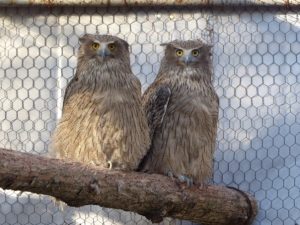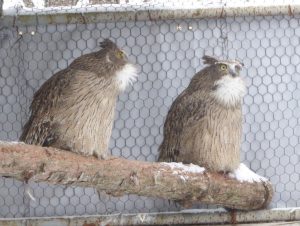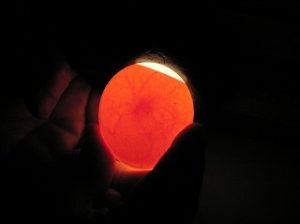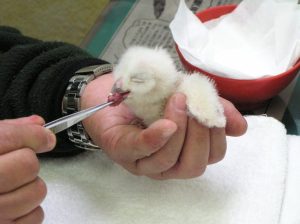Blakiston’s fish owl, the god that watched over the villages
Kushiro Zoo
Satoshi Fujimoto
Blakiston’s fish owl (scientific name, Bubo blakistoni) is one of the world’s largest owls that is extant only in Hokkaido in Japan. Its size is approximately 70 cm and 180 cm in total length and wingspan, respectively, with males and females weighing approximately 3.5 kg and 4.5 kg, respectively. It mainly feeds on fish and also preys on frogs, mice, and other birds. The Blakiston’s fish owl was designated as a natural monument according to the Act on Protection of Cultural Properties in 1971, and as a nationally rare species of wild fauna/flora according to the Act on Conservation of Endangered Species of Wild Fauna and Flora (Species Conservation Act) in 1993. According to an announcement by the Ministry of the Environment of Japan, there are currently only about 140 individuals (about 60 pairs) that inhabit the eastern part of Hokkaido. About 1,000 individuals of another subspecies of the Blakiston’s fish owl are extant in the Ussuri region in the Eurasian continent. The International Union for Conservation of Nature (IUCN) Red List classifies the overall Blakiston’s fish owl species as EN (Endangered: high risk of extinction in the wild in the near future). The Red List of the Ministry of the Environment of Japan classifies the Blakiston’s fish owls that inhabit Hokkaido as CR (Critically Endangered: extremely high risk of extinction in the wild in the very near future).

Fig. 1. Blakiston’s fish owl (left: male, right: female)
Ainu and Blakiston’s fish owl
Many animals are treated as gods by the Ainu people. True gods live in the world of the gods (Kamuy Mosir), and in the human world (Ainu Mosir), the gods take on a different form and provide bounties (e.g., fur and meat) to humans or serve as messengers from the world of the gods. Blakiston’s fish owl is called Kotan Kor Kamuy and is regarded as a god (Kamuy) that watches over villages (Kotan). However, this is no unified name for them, and its name differs depending on the region, including names such as Humhum Okkai Kamuy (“sacred man who sings ‘Humhum’”), Kamuy Chikap (“sacred bird”), and Kamuy Ekashi (“god /old man”). However, it appears to be a beloved god in all regions, and although the ritual (Iomante), in which gods that were sent to the human world are sent back to the world of the gods, is well-known regarding brown bears, there are also regions that viewed the Blakiston’s fish owl as important. This also appears to have been the case in the area around Kushiro. There is indeed something that feels sacred in the Blakiston’s fish owls’ calls (males call with the sound “boo-boo”, and females respond with the sound “uuu”) (Fig. 2). There is a story in Ainu folklore about the Blakiston’s fish owl informing the gods about the impoverished human life. Therefore, the gods flowed willow leaves into the river and gave Shishamo (literally “willow leaf fish” in Ainu language) to humans. The Blakiston’s fish owl appears to have been a species very familiar to the Ainu people in the past. Today, they only inhabit a few deep remote forests, mainly in the eastern part of Hokkaido. In such circumstances, they certainly cannot convey the trends of human society to the gods.

Fig. 2. Male on the left can be seen calling, to which the female on the right can be seen responding
Current status of Blakiston’s fish owl
It was estimated that there were around 1,000 individuals living throughout Hokkaido around 1900. A habitat survey conducted by the Hokkaido Agency in eastern Hokkaido in 1975–1976 confirmed only 29 individuals, alerting authorities to the significant risk of extinction. At the time, it was estimated that there were around 70 individuals throughout Hokkaido. It is thought that development is the primary cause of population decline within this species. The Blakiston’s fish owl prefers to use tree hollows as nests. A tree hollow that is large enough for a large Blakiston’s fish owl to enter and exit requires the tree to have grown to a diameter of approximately one meter before beginning to decay, which requires a long period of approximately 100 years. Despite the abundance of nature in Hokkaido, there are very few such trees in the area (due to deforestation and agricultural land development). Furthermore, a density of approximately 100 fish (5 kg) per 100 square meters of river is needed for successful breeding. There are few such abundant rivers today (due to environmental pollution, river improvements for hydraulic control, and sand control dams/irrigation weirs). Factors that threaten the owls’ habitat also include human factors such as the impact on breeding due to the visitations by humans (e.g., photographers and birdwatchers) in these habitats, accidents of the birds getting caught in fishing nets, traffic accidents, and electric pole accidents.
Zoos and Blakiston’s fish owl
The oldest records of captivity of the Blakiston’s fish owl in zoos is of that in Ueno Zoo, with a record of the owl being donated to the Zoo in 1875 (Meiji 8) prior to its opening in 1882 (Meiji 15), with records of nine individuals by 1912 (Taisho 1). The captivity of the birds for exhibition purposes was resumed in several zoos from 1954 (Showa 29), but this did not lead to breeding due to single birds being kept captive and the sex of the individual birds being unknown.
Kushiro Zoo determined the sex of individuals whose sexes were unknown and succeeded in forming a pair, with a first successful laying of eggs in 1982. However, these eggs did not hatch (Fig. 3).

Fig. 3. Inspection of the fertilized egg
The Japanese Association of Zoos and Aquariums (at the time) held the first Species Conservation Committee in 1988 for maintaining captive populations, where the Blakiston’s fish owl had its pedigree registered and was managed. In 1993, a female individual in Ueno Zoo and a male individual in Hirakawa Zoological Park were transferred to Kushiro Zoo, which kept four female and two male individuals in captivity, for breeding purposes, and an active captive breeding program was started. In 1994, the program successfully achieved hatching of an egg, but the chick died before fledging. In 1995, an individual that was born from the same pair successfully fledged for the first time. To date, 21 eggs from 17 occasions hatched. Natural hatching consisted of 19 eggs (of which five were from brood parasitism) from 15 occasions, and artificially-hatched chicks were from two eggs from two occasions (Fig. 4). Of the hatched chicks, 13 have survived for over a year. Of these, one was transferred to the Ministry of the Environment of Japan and released in 1999 after rehabilitation. This was the first case of wild release of a captive breeding individual. Since 1998, 11 individuals that could not be released were mainly taken over from the Ministry of the Environment and used for captive breeding. Subsequently, from 2011, the captive individuals were moved to Asahikawa Zoo and Maruyama Zoo in Sapporo City to commence distributed breeding, and Maruyama Zoo and Asahikawa Zoo started pair breeding in 2014 and 2016, respectively, with the aim of breeding of new individuals.

Fig. 4. Artificial brooding
Conservation breeding project
In 1984, the Environmental Agency (at the time) began nest box installation, feeding, tagging, and accident prevention measures; in 1993, the Blakiston’s fish owl was designated a nationally rare species of wild fauna/flora with the enforcement of the Species Conservation Act; and a conservation breeding project (Ministry of the Environment / Ministry of Agriculture, Forestry and Fisheries) was formulated. In 1999, the Blakiston’s Fish Owl Wild Mating Promotion Plan (Action Plan) was formulated, which set out the goal of 100 habitat locations and 200 individuals; and based on this plan, the Captive Population Maintenance and Enrichment Plan (draft) (2011), Plan for Environmental Improvements for Habitat Expansion (2013), and Bird Release Procedure (2014) were formulated. The promotion of this project has led to a recovery in the owl population and expansion of its habitat.
Everybody protecting the Blakiston’s fish owl
Blakiston’s fish owl protection activities involve not only those by governments such as national governments, national organizations such as the Wild Bird Society of Japan or the Japanese Society for Preservation of Birds, and zoos and researchers who kept captive birds, but also initiatives by residents in the owls’ habitats to protect the forests and rivers there. It is important that community-based activities be conducted alongside captive breeding and protection in protected areas. Is it not our responsibility to the next generation to take a long-term approach based on a common understanding that everybody should protect the Blakiston’s fish owl?
https://www.city.kushiro.lg.jp/zoo/shoukai/1001527/1001556/1001573.html

